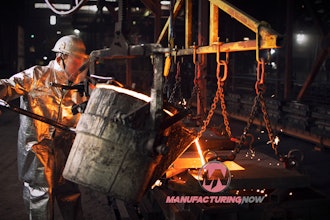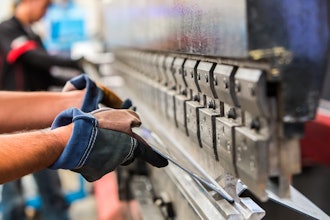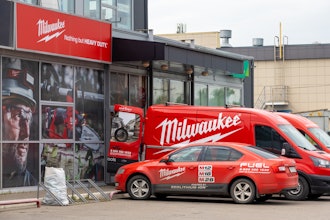Perhaps it’s a dramatic interpretation, but we are talking about life and death here.
Based in Cambridge, MA, OmniGuide Inc. designs and manufactures the world’s most precise optical laser scalpels. Dedicated to expanding the reach of minimally invasive surgery, OmniGuide brings to surgeons the precision of CO2 laser surgery, enabling precision surgery around intricate anatomy and near critical structures.
Gaining An Advantage
|
By utilizing 5S and adjusting floor plans, OmniGuide was able to avoid the costs associated with moving to a new facility. |
Despite being at the cutting edge of product technology, continuous improvement wasn’t always intuitive to OmniGuide. A few years back, the company was facing some serious space issues, and considered a move to a larger facility. The problem was, as a medical device company, moving would be an extraordinarily costly endeavor. “Because we’re a medical device company, we have to validate everything before we can manufacture on it,” explains Doug Woodruff, VP, Quality Assurance and Regulatory Affairs. “So to move means you’re down until you can validate all the equipment, or else you have to replicate all the equipment. Given our size, it would have taken us six to nine months to complete a move.”
Faced with this inconsiderable amount of downtime, OmniGuide began to pursue other solutions. “We knew we had to do something,” says Woodruff. “We decided that with the cost of the move, we’d be better off trying to improve our manufacturing processes.”
GBMP
Luckily for OmniGuide, help was just around the corner, in the form of GBMP (Greater Boston Manufacturing Partnership).
GBMP came into OmniGuide to serve as a leader in the training initiatives, covering areas such as 5S, Value Stream Mapping, and Problem Solving techniques (For more on GBMP, see sidebar, page 9).
With the support of management, the employees at OmniGuide used their newly acquired skills to begin examining many of their work processes. As improvement teams began directly observing the processes required to make OmniGuide laser products, it became apparent that a statistical approach to solving problems was necessary. At that point, 16 employees from several different disciplines began Six Sigma Green Belt training. OmniGuide received a grant from the Massachusetts work force training fund to pay for the training. The company's match for the grant funds was the time their employees spent in training.
Ron Pujalte, Continuous Improvement Manager at GBMP, outlines his approach to a continuous improvement consult: “I try to get out anywhere from 8 to 15 days. The tools are only ten percent of the entire equation. Forty percent of it is creating a favorable environment, and the other fifty percent is actually going out there and making sure everybody is using the tools. I always say, ‘Our first goal is to save 12 minutes a day, because that 12 minutes a day is 50 hours a year that you can spend on continuous improvement.’”
|
A Real Partner GBMP is a not-for-profit corporation whose sole focus is to help small and medium sized manufacturing companies become more productive and competitive through cost-effective Continuous Improvement (Lean Manufacturing and Six Sigma) education and shop-floor implementation. In striving to fulfill this mission, GBMP has become a leading contributor in strengthening industry and increasing employment opportunities in the Northeast, and has also begun working with companies throughout the world. About GBMP Based at the University of Massachusetts Boston campus, GBMP has worked with hundreds of companies, providing suggestions and solutions resulting in millions in cost savings and increased sales. Each year GBMP trains over 7,000 people on Continuous Improvement principles through customized, on-site classroom and shop-floor training sessions and educates over 1,000 more people in public workshops, plant tours and the Manufacturing Roundtable Speaker Series. What is Continuous Improvement? Continuous Improvement connects your employees to your customers by finding and eliminating non-value-added activities in all areas of your business. The key to success is the understanding that Continuous Improvement is all about people. Your employees are in the best position to identify and solve all the little problems that are manifested throughout your business processes. Given a little education and the proper support and encouragement, employees can find and eliminate all the headaches and time anchors that currently prevent you from delighting your customers. Continuous Improvement is about creating an environment where employees can make changes that allow them to spend more time on those things your customers want to pay for. Take a moment to think about your facility in relationship to the following seven forms of waste:
GBMP’s goal is to educate, empower, and energize people and change the way they think and work to strive to eliminate the seven forms of waste from your processes. |
In the end, OmniGuide has accumulated savings of over $4 million dollars and a return on their investment (ROI) exceeding 4,000 percent from the 17 days of training conducted.
Project Sustainability
Chia-Chun Chung, OmniGuide’s Fiber Forensics Team Manager has taken on the role of champion for many of these improvement projects. Her vision for the future lies in maintaining the efforts that OmniGuide has already initiated: “I think a big part of it is just sustaining. We have made a lot of improvement over the last few years, and now that the training program is finished, I think a big challenge is how to keep things going, and how to keep everybody motivated so it becomes self-sustaining,” says Chung. “Currently we have a storyboard program that highlights improvements from each department. They’re a really good communication tool across different departments. Right now, that has grown to highlight big achievements. We want to also see small improvements that may not save us thousands of dollars, but still matter on a day-to-day basis.”
“The storyboard has really become—in the end—very important,” adds Tsachi Avrahami, Director of Manufacturing at OmniGuide. “People don’t feel comfortable talking about very small things. What we’re trying to build is something that does not put emphasis on how big the improvements are, just on the fact that there was something. That actually came from another plant tour that we did through GBMP; there are plant tours that we keep sending people to, so we can learn from other facilities.”
Culture Of Improvement
One unique situation related to OmniGuide's attempt to highlight process inefficiencies by video recording shifts to help best determine the issue. In terms of employee buy-in of the project's goals, some were suspicious.
“One of the things that was important for us was, instead of constantly trying to convince the people that are difficult to convince, is to start with the people who are easier to work with, to let them show the others: hey, it can work, and management listens to me,” explains Avrahami.
“And once they see that these guys have taped their process and they’ve used it in order to make their lives easier, and no one got fired, and no one got yelled at for doing it slower or making a mistake… then they think maybe it’s not such a bad thing, and they get pulled into it too.”
But their efforts to incorporate continuous improvement were not always a simple task, especially when various divisions of the company had such different processes. While the fiber group could create hundreds of units on a daily basis, the preform group only made two. As Avrahami says, “It’s very difficult to actually take one particular item and get a lot of statistics out of it. It’s not a process you can just break down into sub-sets… That’s another thing we had to adjust—the way we approach things to different manufacturing types.”
Don’t forget to mention the different types of people. Commitment at every level of the company is crucial to making a continuous improvement project work, as some employees need convincing to get out of the “I’m improving myself out of a job” mind set, as Chung puts it. In fact, management went into the first Six Sigma meetings with a distinct message: “This is not a way of getting rid of employees.”
Avrahami adds: “It doesn’t matter how much you show off the improvements to the entire company—if someone ends up losing their job, you lose the support.”
The Outsourcing Threat
Avrahami recounts when the suggestion of outsourcing first came up at OmniGuide: “Two years ago, the board was talking to the manufacturing team about starting to think about outsourcing options, as in—which parts of your process do you think you’d be able to outsource? And I haven’t heard that for a quite a while.”
Woodruff wasn’t keen on the suggestion. “One of our operations was facility-intensive,” he explains, “which was the reason we were looking to move. We started looking at China… and I don’t believe that there is any success to be had with that.” Woodruff knew material costs would be the same in the U.S. as they would be in China, so the company decided to hone in on their labor costs instead. “We’ve reduced our labor costs by about 50 percent in two years. If you look at our manufacturing process: before, it was around a corner, up the stairs, and going about five directions back and forth a couple of times. Now it’s laid out in one room; the room looks smaller, but the employees actually have more room.”
Regrets? What Regrets?
Avrahami said if he could have done anything different with OmniGuide’s collaboration with GBMP, it was that he “would have started this process one year earlier. Start before you really need it.”
|
OmniGuide's Chia-Chun Chung and Tsachi Avrahami explain the value of the visibility of storyboards. |
To this Woodruff adds: “Everyone is so concerned about firefighting, but if you spend all your time putting out the little fires, you can’t clear the brush to keep the fires from happening. And you really need to dedicate some resources to clear the brush. For a small company, that’s really hard, because we don’t have excess people. So you really need to make the commitment to allow people to do that.”
Other than the delay, OmniGuide is pleased with their success with GBMP and continuous improvement. Aside from the 50 percent decrease in labor costs, Woodruff explains how OmniGuide has battled the recession with their efforts: “We’re not laying people off; we got through. And because of reductions, we were able to move our people around to other places while we were waiting for it to come back.”
Chung seems to be completely regret-free. “I think we have something great going on here,” she says, “and I’m just trying to keep it going.”


















